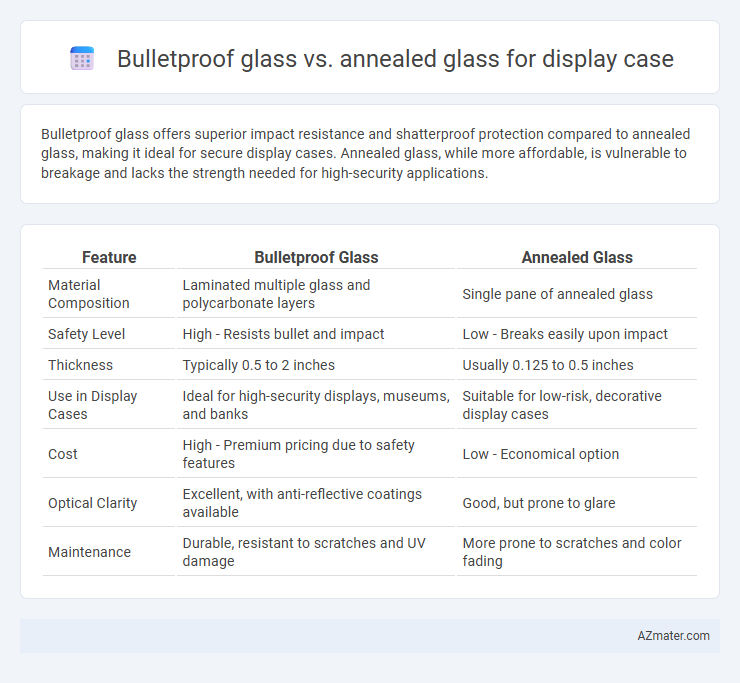Bulletproof glass offers superior impact resistance and shatterproof protection compared to annealed glass, making it ideal for secure display cases. Annealed glass, while more affordable, is vulnerable to breakage and lacks the strength needed for high-security applications.
Table of Comparison
| Feature | Bulletproof Glass | Annealed Glass |
|---|---|---|
| Material Composition | Laminated multiple glass and polycarbonate layers | Single pane of annealed glass |
| Safety Level | High - Resists bullet and impact | Low - Breaks easily upon impact |
| Thickness | Typically 0.5 to 2 inches | Usually 0.125 to 0.5 inches |
| Use in Display Cases | Ideal for high-security displays, museums, and banks | Suitable for low-risk, decorative display cases |
| Cost | High - Premium pricing due to safety features | Low - Economical option |
| Optical Clarity | Excellent, with anti-reflective coatings available | Good, but prone to glare |
| Maintenance | Durable, resistant to scratches and UV damage | More prone to scratches and color fading |
Introduction to Display Case Glass Types
Bulletproof glass for display cases offers superior security with multi-layered, laminated construction that resists impact and prevents shattering, ideal for high-value or vulnerable exhibits. Annealed glass, being standard float glass slowly cooled to relieve internal stresses, provides basic protection but lacks the strength and safety features of bulletproof glass. Selection depends on the required level of security, with bulletproof glass delivering enhanced durability and safety for premium display environments.
Key Differences: Bulletproof vs Annealed Glass
Bulletproof glass for display cases consists of multiple laminated layers of glass and polycarbonate designed to withstand high-impact forces, offering superior protection against break-ins and vandalism. Annealed glass, on the other hand, is a single pane of standard glass that is more prone to shattering upon impact, providing minimal security benefits. The key differences lie in bulletproof glass's enhanced durability, resistance to penetration, and safety features, whereas annealed glass is primarily cost-effective but lacks the strength and resilience required for high-security display enclosures.
Material Composition and Structure
Bulletproof glass for display cases is composed of multiple layers of laminated glass and polycarbonate, providing enhanced impact resistance and shatterproof qualities. Annealed glass consists of a single pane of slowly cooled float glass, making it more prone to breakage and less secure compared to bulletproof variants. The layered structure of bulletproof glass significantly improves durability and safety, ideal for high-security displays.
Security and Protection Levels
Bulletproof glass offers superior security and protection levels compared to annealed glass due to its multi-layer construction with polycarbonate interlayers designed to absorb and dissipate impact energy from ballistic threats and forced entry attempts. Annealed glass, while providing basic protection against scratches and minor impacts, easily shatters upon high impact, offering minimal resistance to break-ins and vandalism in display case applications. For display cases requiring enhanced safeguarding of valuable items, bulletproof glass ensures maximum durability and resistance against penetration, preventing theft and damage more effectively than annealed glass.
Durability and Impact Resistance
Bulletproof glass offers superior durability and impact resistance compared to annealed glass, making it ideal for high-security display cases. Designed with multiple laminated layers, bulletproof glass can withstand significant force and prevent shattering upon impact. In contrast, annealed glass lacks the structural reinforcement, making it prone to cracking or breaking under stress.
Visual Clarity and Aesthetic Considerations
Bulletproof glass for display cases offers superior impact resistance but may have slight optical distortions or increased thickness that can affect visual clarity compared to annealed glass. Annealed glass provides excellent transparency and a sleek, minimalistic appearance that enhances the aesthetic appeal of display cases due to its uniform edges and thinner profile. For premium showcases where visual clarity and elegance are paramount, annealed glass is often preferred unless enhanced security is a critical requirement.
Cost Comparison: Bulletproof vs Annealed Glass
Bulletproof glass for display cases incurs significantly higher costs, typically ranging from $70 to $120 per square foot, compared to annealed glass, which costs around $15 to $30 per square foot. The increased expense reflects bulletproof glass's multi-layered construction with polycarbonate interlayers, enhancing security and impact resistance, unlike single-pane annealed glass. Despite the higher upfront investment, bulletproof glass provides superior protection for high-value or vulnerable displays, justifying its price in security-critical environments.
Installation Challenges and Requirements
Bulletproof glass for display cases demands precise installation techniques due to its significant weight and thickness, requiring reinforced frames and specialized mounting hardware to ensure safety and stability. Annealed glass, being thinner and lighter, offers easier handling and faster installation but poses higher risks of breakage under impact, necessitating careful alignment and moderate structural support. Both materials require skilled labor, but bulletproof glass installations involve stricter compliance with safety codes and more extensive preparation to accommodate its robustness.
Maintenance and Longevity
Bulletproof glass offers superior durability and resistance to scratches and impacts, significantly reducing the need for frequent maintenance compared to annealed glass in display cases. Annealed glass, while more cost-effective, is more prone to cracks and breakage, leading to higher replacement rates and lower overall longevity. Investing in bulletproof glass ensures prolonged structural integrity and minimal upkeep, enhancing the lifespan of display enclosures.
Choosing the Right Glass for Your Display Case
Choosing the right glass for your display case involves balancing security and clarity, where bulletproof glass offers superior impact resistance and protection against break-ins compared to annealed glass. Bulletproof glass, typically laminated with polycarbonate layers, prevents shattering upon strong impacts, making it ideal for high-value or sensitive items. Annealed glass provides clarity and affordability but lacks the strength and safety features needed for secure display cases in high-risk environments.

Infographic: Bulletproof glass vs Annealed glass for Display case
 azmater.com
azmater.com